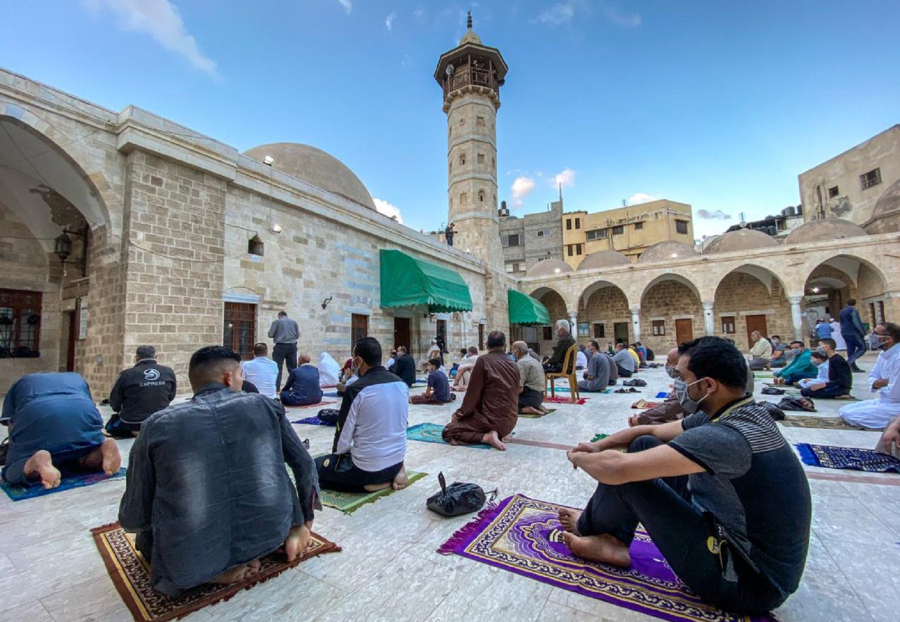Gaza City is a land full of martyrs' dreams, an ancient land with monuments and historical monuments, fortified mosques and churches that tell their historical history with their bells, markets as old as its historical civilization.
One of the most famous old places in Gaza is the Al-Omari Mosque, which was converted into a mosque with a minaret during the time of Omar Ibn Al-Khattab. This mosque was originally a church built by the Bishop of Gaza, but with the Muslim conquest it was transformed into a large mosque with an area of 4100 square meters, whose corridors have 38 huge marble columns.
The passage of time on this large mosque in the historical periods of Islamic civilization and the severe disasters of the time made it in need of reconstruction and restoration. In the 1920s, the Supreme Islamic Council of Palestine restored and expanded this mosque. This mosque was partially destroyed in the attacks of the Zionist regime aimed at destroying the ancient and Islamic monuments of Gaza.
One of the most important and largest mosques in Gaza City is the Sayyid Hashim Mosque, named after Hashim ibn Abd Manaf, the grandfather of the Prophet Muhammad (PBUH), in the Al-Darj area of Gaza. The shrine of Hashim Abd Manaf is located in the northwest corner of the mosque. The mosque has been partially destroyed in recent attacks by the Zionist regime.
According to historians, the mosque dates back to the Mamluk period and is considered one of the most beautiful buildings in Gaza. . The mosque consists of an open courtyard surrounded by four canopies, the largest of which is the qibla canopy in a room that opens towards the western canopy near the shrine of Hashim ibn Abd Manaf, the grandfather of the Prophet Muhammad (PBUH).
Then, the Ottoman Sultan Abdul Hamid II renovated and expanded it in the late 9th century. The current building of the mosque dates back to 1850, when it was renovated on the orders of Abdul Hamid II.
This mosque is located one kilometer from the Al-Omari Grand Mosque. Inside the mosque is a madrasa built by the Palestinian Islamic Supreme Council. The dome of this mosque was destroyed in World War I, but the Palestinian Islamic Supreme Council rebuilt and restored it.
Hashim Abd Manaf died on his last trip to Gaza, where he came for business. His tomb collapsed in the early 12th century, and the residents of Gaza built a wall around this tomb. In 1855, Sultan Abdul Hamid II, at the request of the Mufti of Palestine, built a mosque near this tomb, which today houses the tomb of the Prophet's grandfather.
This mosque is built in the Mamluk architectural style, and its southern, northern and western porches have 19 stone columns, 17 small domes and two large domes. The main prayer hall of the mosque is located on the eastern side and resembles a square, its mihrab faces the qibla and has a pulpit.
The area of the mosque is 2,371 square meters. The courtyard of the mosque is made of marble and its columns are also covered with marble. The walls of the Sayyid Hashim Mosque are 90 cm thick to support the stone domes.
The tomb of Sayyid Hashim is located on the northwest side of the mosque. The tomb is located in a square room with a large dome on top. The dome has eight windows that are placed to illuminate the tomb.
Another old mosque in Gaza that was attacked by the Zionist regime is the “Ibn Othman Mosque” in the Shuja’iyah area in eastern Gaza City. This mosque was built in the 8th century AH. The design of this historic and old mosque in the Mamluk style was done by Sheikh Ahmed bin Othman.
The “Sheikh Abdullah” Mosque is an old mosque in the Al-Taffa area in eastern Gaza that was built during the Mamluk period.
The most famous mosques in Gaza include the Maghrib Mosque in the Al-Darraj neighborhood, the “Al-Mahkama Bardakiyyah” mosque, which was founded by Prince Bardik Al-Dodar in 859 AH, the “Al-Zafrd Al-Miri Mosque”, the “Al-Sheikh Zakaria Mosque”; The mosques of Ismail Abu Shanab and Tal al-Mantar are mentioned.


















